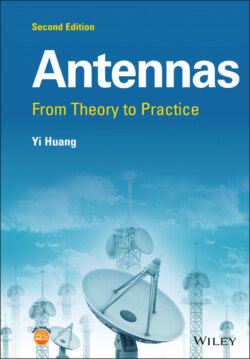Читать книгу Antennas - Yi Huang - Страница 10
Оглавление
Preface to the First Edition
As an essential element of a radio system, the antenna has always been an interesting but difficult subject for radio‐frequency (RF) engineering students and engineers. Many good books on antennas have been published over the years, and some of them were used as our major references.
This book is different from other antenna books. It is especially designed for people who know little about antennas but would like to learn this subject from the very basics to practical antenna analysis, design, and measurement within a relatively short period of time. In order to gain a comprehensive understanding of antennas, one must know about transmission lines and radio propagation. At the moment, people often have to read a number of different books, which may not be well correlated. Thus, it is not the most efficient way to study the subject. In this book, we put all the necessary information about antennas into a single volume and try to examine antennas from both the circuit point of view and the field point of view. The book covers the basic transmission line and radio propagation theories, which are then used to gain a good understanding of antenna basics and theory. Various antennas are examined and design examples are presented. Particular attention is given to modern computer‐aided antenna design. Both basic and advanced computer software packages are used in examples to illustrate how they can be used for antenna analysis and design. Antenna measurement theory and techniques are also addressed. Some special topics on the latest antenna development are covered in the final chapter.
The material covered in the book is mainly based on a successful short course on antennas for practicing professionals at the University of Oxford and the Antennas module for students at the University of Liverpool. The book covers important and timely issues involving modern practical antenna design and theory. Many examples and questions are given in each chapter. It is an ideal textbook for university antenna courses, professional training courses, and self‐study. It is also a valuable reference for engineers and designers who work with RF engineering, radar and radio communications.
The book is organized as follows:
Chapter 1: Introduction. The objective of this chapter is to introduce the concept of antennas and review essential mathematics and electromagnetics, especially Maxwell’s equations. Material properties (permittivity, permeability, and conductivity) are discussed, and some common ones are tabulated.
Chapter 2: Circuit Concepts and Transmission Lines. The concepts of lumped and distributed systems are established. The focus is placed on the fundamentals and characteristics of transmission lines. A comparison of various transmission lines and connectors is presented. The Smith Chart, impedance matching, and bandwidth are also addressed in this chapter.
Chapter 3: Field Concepts and Radio Waves. Field concepts, including the plane wave, intrinsic impedance, and polarization, are introduced and followed by a discussion on radio propagation mechanisms and radio wave propagation characteristics in various media. Some basic radio propagation models are introduced, and circuit concepts and field concepts are compared at the end of this chapter.
Chapter 4: Antenna Basics. The essential and important parameters of an antenna (such as the radiation pattern, gain, and input impedance) are addressed from both the circuit point of view and field point of view. Through this chapter, you will become familiar with antenna language, understand how antennas work, and know what design considerations are.
Chapter 5: Popular Antennas. In this long chapter, some of the most popular antennas (wire‐type, aperture‐type, and array antennas) are examined and analyzed using relevant antenna theories. The aim is to see why they have become popular, what their major features and properties are (including advantages and disadvantages), and how they should be designed.
Chapter 6: Computer‐Aided Antenna Design and Analysis. The aim of this special and unique chapter is to give a brief review of antenna‐modeling methods and software development, introduce the basic theory behind computer simulation tools, and demonstrate how to use industry standard software to analyze and design antennas. Two software packages (one is simple and free) are presented with step‐by‐step illustrations.
Chapter 7: Antenna Manufacturing and Measurements. This is another practical chapter to address two important issues: how to make an antenna and how to conduct antenna measurement, with a focus placed on the measurement. It introduces S‐parameters and equipment. A good overview of the possible measurement systems is provided with an in‐depth example. Some measurement techniques and problems are also presented.
Chapter 8: Special Topics. This final chapter presents some of the latest important developments in antennas. It covers mobile antennas and antenna diversity, RFID antennas, multiband and broadband antennas, reconfigurable antennas, and electrically small antennas. Both the theory and practical examples are given.
The authors are indebted to the many individuals who provided useful comments, suggestions, and assistance to make this book a reality. In particular, we would like to thank Shahzad Maqbool, Barry Cheeseman, and Yang Lu at the University of Liverpool for constructive feedback and producing figures, Staff at Wiley for their help and critical review of the book, Lars Foged at SATIMO and Mike Hillbun at Diamond Engineering for their contribution to Chapter 7, and the individuals and organizations who have provided us with their figures or allowed us to reproduce their figures.
Yi Huang and Kevin Boyle
